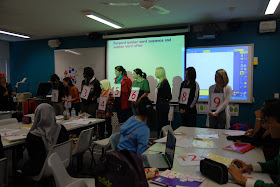When an understanding of numerals has been acquired by the students, teachers will begin to teach the process of reciting numbers in a particular order, or counting. Gelman and Gallistel (1992) state that counting involves a number of different principles. The most common ones are one-to-one principle, stable-order principle, cardinal principle, abstraction principle and order-irrelevance principle. Teachers may use the following learning experiences to develop the students’ ability to count.
One-to-one principle: When counting, only one number word is assigned to each object.
Stable-order principle: When counting, number words are always assigned in the same order.
Cardinal principle: Having knowledge that the last number name said describes the total quantity.
Order-irrelevance principle: When counting the number of objects in a set, the order they are counted is irrelevant, as long as each object is counted.
Abstraction principle: Students realise that numbers can be used to count anything.
Below is a link to a website that helps students to count.
http://www.abc.net.au/countusin/
http://www.abc.net.au/countusin/
Teachers can use resources like this in their classroom to ensure learners grasp their first step in Maths and able to count at early age.








No comments:
Post a Comment